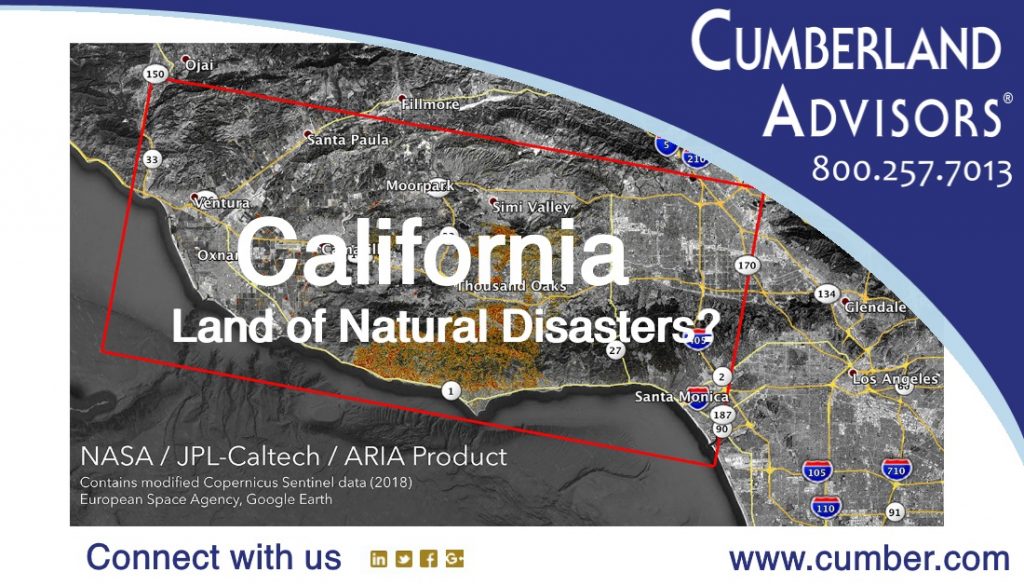Last week we conducted a review of our California municipal bond holdings along the San Andreas Fault looking for holdings that may be more susceptible to credit deterioration in the event of a disaster. At the time, little did we know that wildfires would engulf large swaths of California.
[caption id="attachment_42492" align="aligncenter" width="474"] The Advanced Rapid Imaging & Analysis (ARIA) team at NASA's Jet Propulsion Lab in Pasadena, CA, created these Damage Proxy Maps (DPMs) depicting areas in California likely damaged by the Woolsey & Camp Fires.[/caption]
The Advanced Rapid Imaging & Analysis (ARIA) team at NASA's Jet Propulsion Lab in Pasadena, CA, created these Damage Proxy Maps (DPMs) depicting areas in California likely damaged by the Woolsey & Camp Fires.[/caption]
First, our hearts and prayers go out all those affected by the wildfires and their loved ones and friends, including firefighters, volunteers, and those housing the displaced.
We monitor our portfolios on a regular basis. The majority of our holdings are in AA-rated credits that have economic diversity, good wealth and income indicators, and strong financial management, exemplified by ample reserves and liquidity. During the monitoring process we look for changes in credit quality of our holdings and we evaluate bonds that new clients have sent us to manage; and if they do not meet our credit parameters we sell them.
A state of emergency and a major disaster have both been declared in California. The declarations by the governor of the State of California (and the governor elect) and the president ensure that the Federal Emergency Management Agency (FEMA) will provide funding and other resources to help rebuild and provide shelter and other aid in the wake of the fires. We have seen from other disasters that the rebuilding effort generally produces an increase in spending and other economic activity, such that sales taxes and other revenues flow to the municipalities in the state and sometimes improve credit quality in the long run.
Many areas of the state have been affected, including the town of Paradise, which lies in ruins, and no socioeconomic class has been spared. See this CNN piece on the fire damage: “44 dead in California fires as the Camp Fire becomes the deadliest in state history,” https://www.cnn.com/2018/11/12/us/california-wildfires-woolsey-camp-hill-missing/index.html. And here is a Bloomberg report: “California Ablaze: The State’s Devastating Wildfires in Pictures,” https://www.bloomberg.com/news/photo-essays/2018-11-09/massive-wildfires-rage-across-california. Statewide, damage estimates are large and continue to grow. Some of the damage will be covered by insurance proceeds and local money, in addition to FEMA funds.
The state and many local California governments do have the liquidity to foot the initial costs – though as we have written, some municipalities do not have reserves as robust as might be expected this far into an expansion. See our Q3 municipal credit commentary: http://www.cumber.com/q3-2018-municipal-credit-commentary/http://www.cumber.com/q3-2018-municipal-credit-commentary/. So there could well be initial financial stress as communities address the damage.
The continual onslaught of disasters afflicting California this year, on top of the fires last year, gives us pause. What do these events mean for the livability of the state, and what will be the effect on population flows going forward? The past has shown that the state remains desirable, but from time to time growth and related financial stability have varied. We should also remember that California is the fifth largest economy in the world in terms of GDP. It has substantial financial wherewithal to mitigate concerns.
Diversification is a tenet of investment management. The proverbial “Don’t put all your eggs in one basket” comes to mind. Cumberland strives to construct diverse portfolios of municipal bonds, including state-specific portfolios where the client benefits from state tax exemption. The portfolios of many of our California clients are also state-specific, because of the high local income taxes charged in the state. We look for geographical diversification, including having out-of-state bonds in state-specific portfolios. We also diversify among types of credits or sectors, from general-obligation to water or healthcare-system revenue bonds. In addition we diversify through bonds that have been prerefunded (secured by US obligations in an escrow account) or that are insured. Diversification provides a level of insulation from a regional disaster or an industry dislocation, among other risks.
Patricia Healy, CFA
Senior Vice President of Research and Portfolio Manager
Email | Bio
Links to other websites or electronic media controlled or offered by Third-Parties (non-affiliates of Cumberland Advisors) are provided only as a reference and courtesy to our users. Cumberland Advisors has no control over such websites, does not recommend or endorse any opinions, ideas, products, information, or content of such sites, and makes no warranties as to the accuracy, completeness, reliability or suitability of their content. Cumberland Advisors hereby disclaims liability for any information, materials, products or services posted or offered at any of the Third-Party websites. The Third-Party may have a privacy and/or security policy different from that of Cumberland Advisors. Therefore, please refer to the specific privacy and security policies of the Third-Party when accessing their websites.
Sign up for our FREE Cumberland Market Commentaries
Cumberland Advisors Market Commentaries offer insights and analysis on upcoming, important economic issues that potentially impact global financial markets. Our team shares their thinking on global economic developments, market news and other factors that often influence investment opportunities and strategies.

